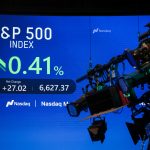
S&P 500 Posts Best May Performance Since 1990, Defying Sell-Off Tradition
5 minute read

Wall Street Seasonal Trading Pattern Upended as Stock Market Records Strongest Spring Rally in 33 Years
Three Key Facts
- The S&P 500 achieved its best May performance since 1990, gaining 6% and challenging the traditional “sell in May and go away” investment strategy
- Market data shows over 10% declines occurred in 30 of the past 53 years, with over 20% drops in 13 years, yet long-term returns remain superior for committed investors
- September statistically shows the weakest performance with an average -0.7% return since 1950, contradicting the common belief that May presents the greatest risk
Introduction
The stock market’s strongest May performance in over three decades has shattered one of Wall Street’s most enduring myths. The S&P 500’s impressive 6% gain this May marks its best showing since 1990, directly contradicting the popular “sell in May and go away” strategy that has guided investors for decades.
This dramatic performance challenges investment wisdom dating back to 1950, when Yale Hirsch first documented the seasonal pattern suggesting investors should exit markets during summer months. The results demonstrate how rigid adherence to seasonal patterns can cost investors significant returns and highlight the importance of maintaining long-term investment perspectives.
Expert Opinions and Data
Max King argues that relying on seasonal patterns impoverishes investors, pointing to May’s exceptional performance as evidence. The current results stand in stark contrast to historical expectations, with the UK’s FTSE All-Share index also posting gains of 3.5% during the same period.
Duncan Lamont of Schroders provides crucial context, noting that market volatility represents the short-term cost for superior long-term returns. His analysis reveals that the MSCI World index has experienced significant declines regularly, yet staying invested proves more profitable than timing market exits.
Key Developments
The traditional seasonal pattern emerged from observations about corporate earnings cycles. By spring, companies complete prior year reporting and establish current year forecasts, creating periods of relative stability until autumn earnings seasons begin.
Recent emphasis on quarterly earnings reports has altered these historical patterns. The increased frequency of corporate updates provides more continuous information flow, reducing the stark seasonal differences observed in earlier decades.
This year’s performance illustrates how unexpected events can disrupt established patterns. Despite typically strong periods, the S&P 500 initially fell 2.4% between October and May, dropping 5% in early months due to concerns over trade policy changes.
Market Impact
The “sell in May” strategy creates measurable costs for investors beyond missed opportunities. Transaction expenses from frequent buying and selling erode returns, while market timing often leads to emotional decision-making that further undermines performance.
According to MoneyWeek, evidence suggests maintaining positions rather than exiting, though setting modest expectations during summer months remains prudent. This approach affects global markets, with international indices often following Wall Street’s leadership patterns.
Market corrections present opportunities rather than reasons for panic. Ed Yardeni observes that US retail investors, particularly younger demographics, increasingly adopt “buy the dip” strategies, viewing volatility as chances to accumulate positions at favorable prices.
Strategic Insights
The Stock Trader’s Almanac reveals that October functions more as a “bear-killer,” reversing numerous bear markets rather than initiating them. Major crashes in 1929 and 1987 followed significant earlier gains, with overconfidence and automated trading strategies amplifying panic rather than seasonal factors causing initial declines.
September emerges as statistically weaker than May, averaging -0.7% returns since 1950. This data contradicts common perceptions about May’s dangers while highlighting how selective memory influences investment folklore.
Individual circumstances should supersede seasonal generalizations. Personal risk tolerance, investment timelines, and financial objectives provide better guidance than historical patterns that may no longer reflect current market dynamics.
Conclusion
May’s exceptional performance demonstrates the limitations of seasonal investment strategies that dominated earlier market eras. The 6% gain represents missed opportunities for investors who followed traditional “sell in May” guidance, while those who remained invested captured significant returns.
Market volatility continues serving as the price for long-term growth, with data showing regular corrections alongside sustained upward trends over extended periods. The evidence supports maintaining diversified positions throughout market cycles rather than attempting to time seasonal patterns that increasingly prove unreliable in modern trading environments.








